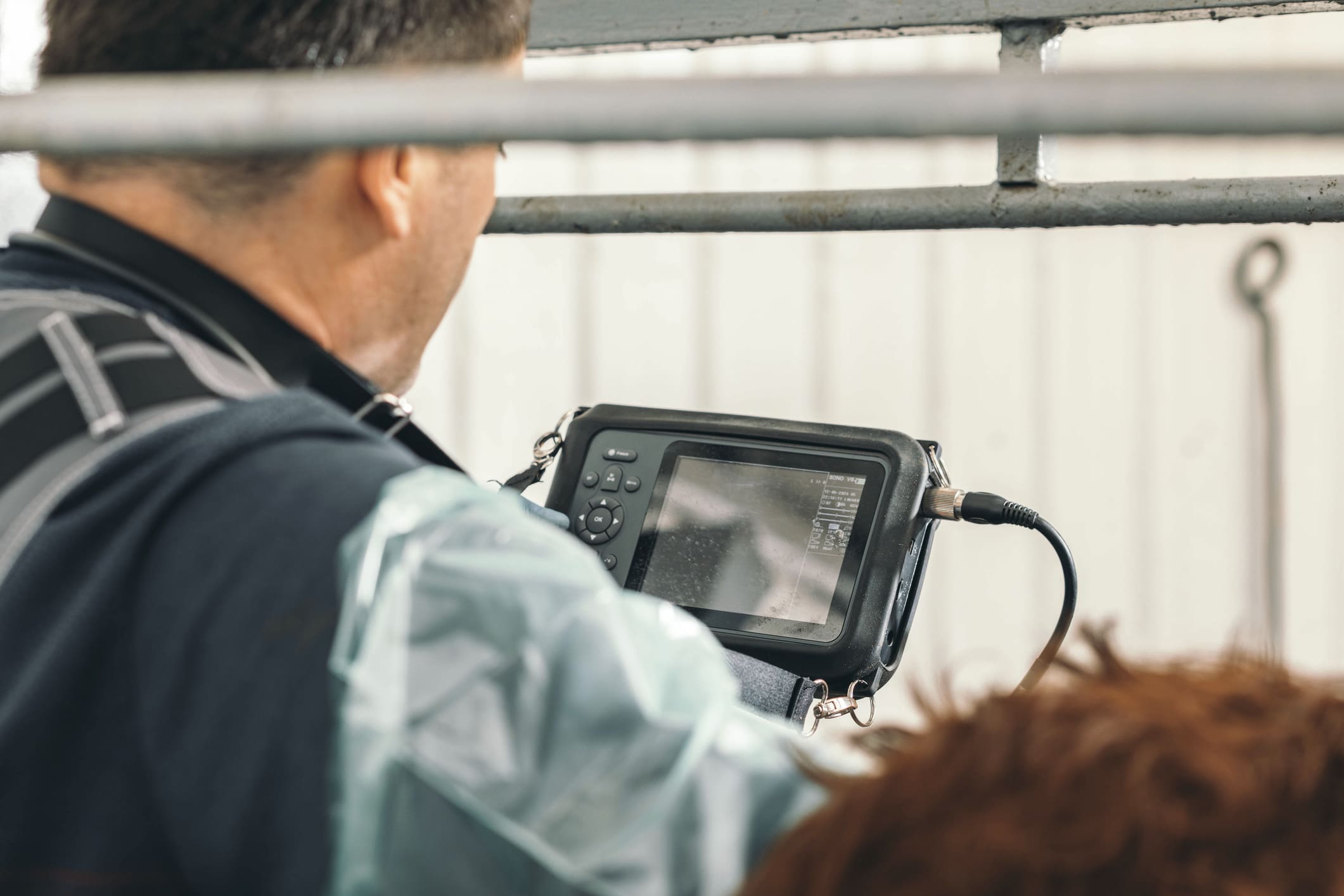This article highlights the importance of using cattle ultrasound to optimize dairy reproduction. Reproductive management is vital in livestock farms and, when optimized, can improve cow health, productivity and economic efficiency. In dairy farms, reproductive efficiency is essential to ensure a sustainable business. Ultrasound technology (ULTS) is a powerful ally in reproductive management. With it, practitioners can be more efficient in reproductive management, reduce calving intervals and achieve better health management.
Dairy farms rely on milk production, which requires calving. For this reason, excellent reproductive management is essential. It's clear that without proper and efficient reproductive management, dairy farms will face significant challenges to remain sustainable.
Prefer to listen to this article? Click the play button below and enjoy our podcast!
Cattle Ultrasound in Dairy Reproduction – your best friend?
Ultrasound imaging can be used in a wide range of applications in dairy reproduction: from monitoring ovarian activity to diagnosing pregnancy and assessing foetal health. The use of ultrasound into reproductive management protocols has been shown to improve reproductive efficiency by: enhancing the decision making in the application of the correct protocols for the re-synchronisation of open cows, shortening calving intervals, and reducing reproductive culling rates.
Indeed, ultrasound provides reliable information for selecting appropriate re-synchronisation protocols in open cows. By identifying the presence or absence of follicles and corpora lutea at the time of a negative pregnancy diagnosis, ultrasound enables clinicians to detect structures that would be difficult, if not impossible, to identify through rectal palpation.

Regarding early pregnancy diagnosis, rectal palpation can confirm pregnancy after 35–45 days post-insemination. ULTS can detect pregnancy as early as 25–30 days post-insemination by visualizing the embryonic vesicle and heartbeats. Early pregnancy detection allows the identification of non-pregnant cows sooner, enabling timely rebreeding and reducing the time between calving and conception.
After ensuring that our cows are pregnant, monitoring fetal health and development can be more accurate with the help of ULTS: assessment of fetal viability (detecting the heartbeat and monitoring fetal growth). Additionally, ultrasound can detect early signs of abnormal pregnancies, such as twin pregnancies, which can present risks to both the cow and the fetuses.
The ability to identify fetal abnormalities early allows for better informed management decisions, such as adjusting nutritional programs or preparing for potential complications during calving. This can increase animal welfare and reduce economic losses associated with dystocia or calf mortality. Furthermore, cattle ultrasound can aid in sex determination by visualizing the external genitalia of the fetus, providing valuable information for herd management and future breeding strategies.
After calving, ULTS can also be valuable in monitoring postpartum by aiding in the assessment of uterine involution and detect postpartum complication such as retained placenta, metritis, or endometritis. Early detection and treatment of these conditions can improve fertility and reduce the risk of prolonged calving intervals.

So ULTS seems to be a farmer's best friend when it comes to reproductive efficiency.
However…
Downsides of Ultrasound in Dairy Reproduction
- Skilled clinicians are required to operate ULTS and interpret the images accurately. Proper use of ultrasound demands training, and misinterpretation of results can lead to reproductive issues, bad AI timing or incorrect diagnoses. Access to trained veterinarians may be limited, especially in remote areas.
- ULTS is time-consuming, especially in large herds. Each cow requires individual handling and scanning, which can slow down farm operations and increase labour costs.
- High equipment costs are an issue as ultrasound equipment can be expensive, and regular maintenance adds to long-term expenses.
- Lastly, ultrasound should be combined with other diagnostic tools. While effective for early pregnancy detection, certain issues like early embryonic loss or subtle reproductive disorders may not be visible immediately, requiring follow-up scans or alternative diagnostic tools.
Take home messages
Ultrasound technology is transforming the management of dairy reproduction, offering a more accurate, efficient, and proactive approach to herd reproductive health. As ultrasound technology continues to advance, its role in optimizing dairy reproduction will become increasingly important for practitioners. However, while cattle ultrasound is a powerful tool in reproductive management, its cost, required expertise, time commitment and detection limits — must be considered to ensure its optimal use.
References
- Fricke, P. M., & Lamb, G. C. (2005). Practical applications of ultrasound for reproductive management of cattle. Journal of Dairy Science, 88(5), 1948–1953. https://doi.org/10.3168/jds.S0022-0302(05)72870-X
- Ginther, O. J. (2014). How ultrasound technologies have expanded and revolutionized research in reproduction in large animals. Theriogenology, 81(1), 112–125. https://doi.org/10.1016/j.theriogenology.2013.09.008
- Pierson, R. A., & Adams, G. P. (1995). Computer-assisted image analysis, diagnostic ultrasonography and ovulation induction: Application to reproductive management in domestic animals. Theriogenology, 43(1), 81–91. https://doi.org/10.1016/0093-691X(94)00009-E
- González-Bulnes, A., Santiago-Moreno, J., & García-García, R. M. (2010). Advances in ultrasonography for the reproductive management of sheep and goats. Reproduction in Domestic Animals, 45, 37–44. https://doi.org/10.1111/j.1439-0531.2010.01638.x
About the author
Ana Vanessa Dias Sousa (Researcher FeedInov CoLAB)
With a degree in Veterinary Sciences from the University of Trás-os-Montes and Alto Douro, she worked for five years as a field veterinarian and in a pig and cattle feed factory. She worked in the pharmaceutical industry as a sales manager and technical support for pigs, cattle, rabbits and poultry in mainland Portugal and the Azores. She is currently at Feedinov Colab as a Researcher in the One Health Department.
Explore author’s articles



Leave your comments here